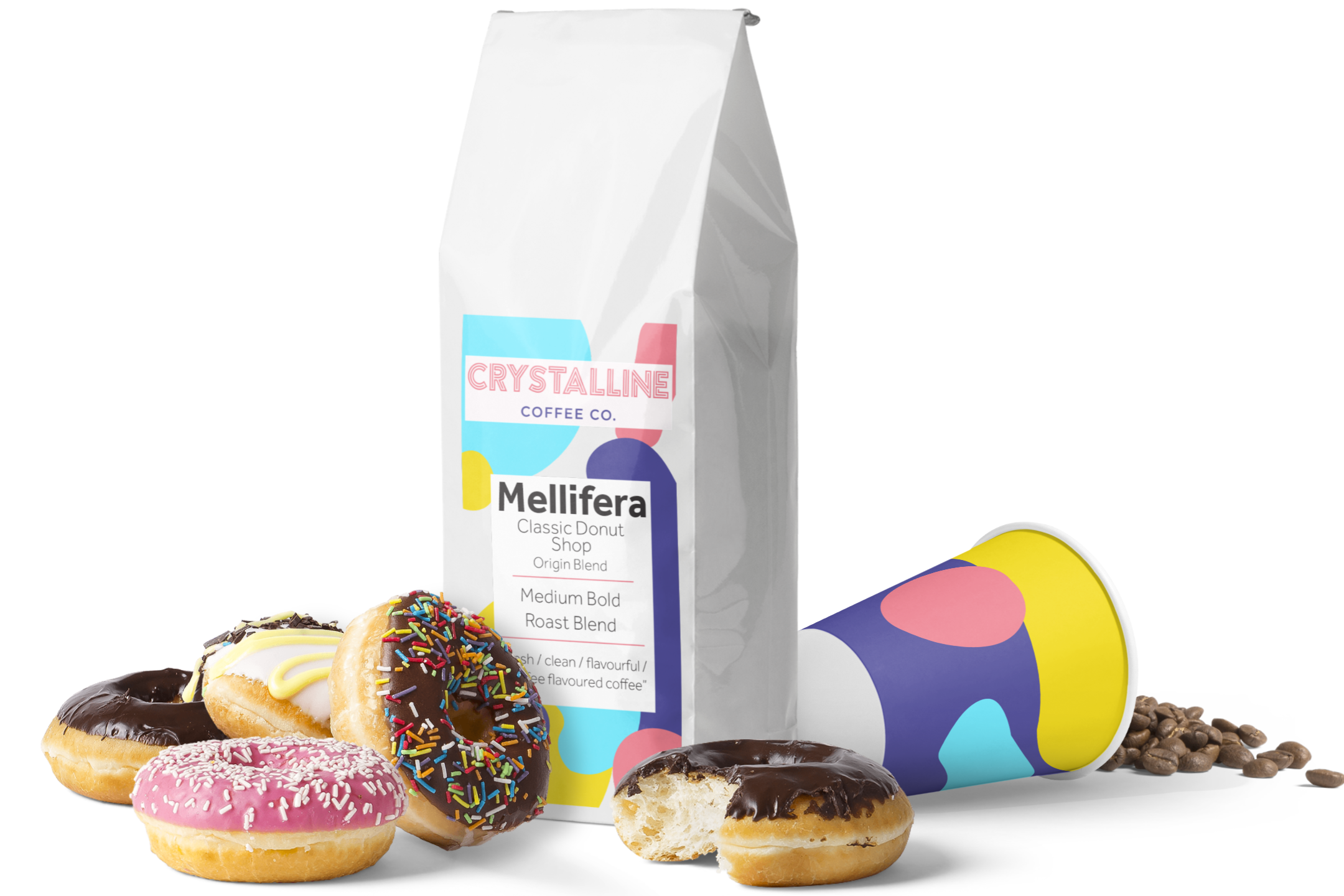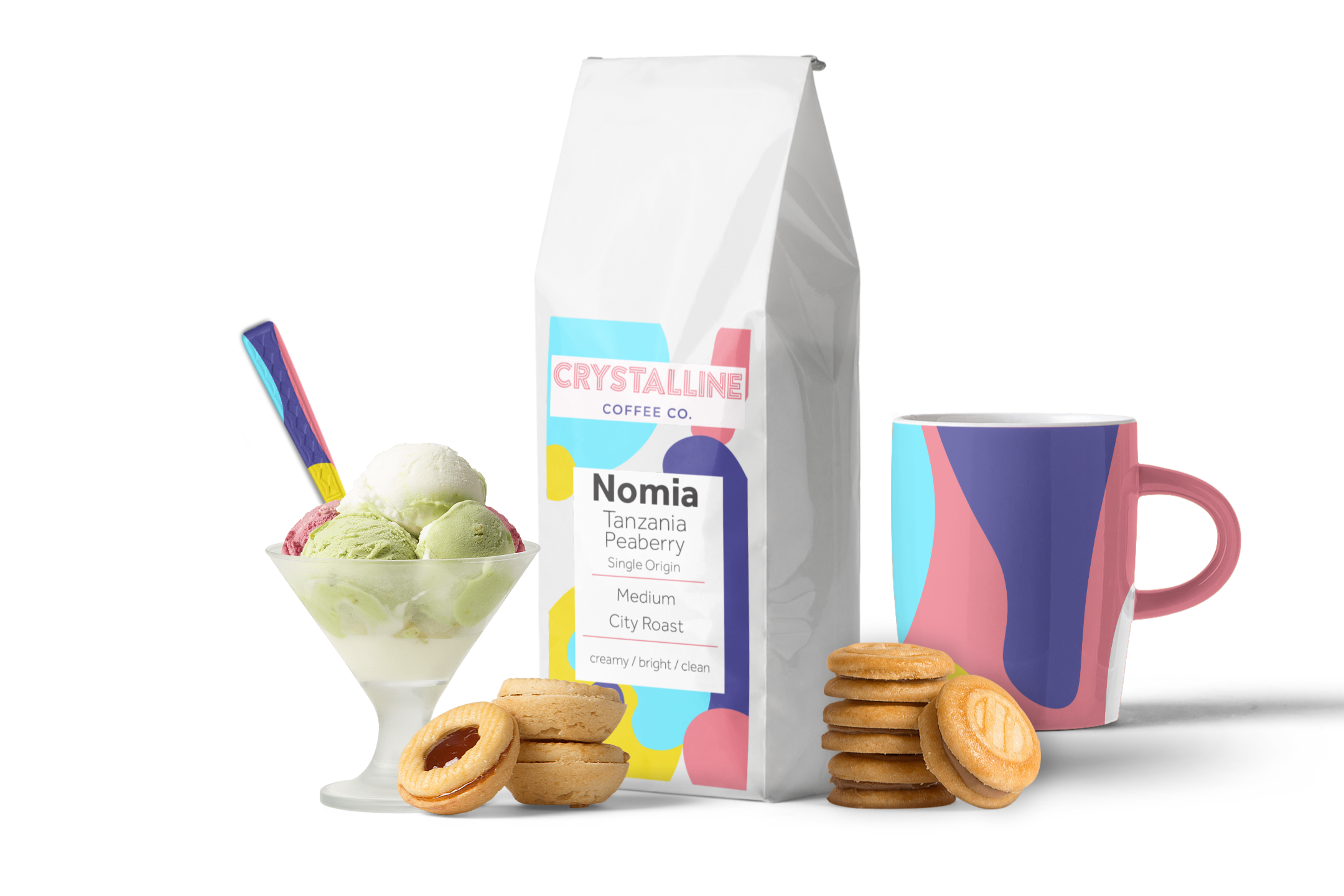Crystalline Coffee is named after the bees. It is our way of showing appreciation for these important pollinators, while also giving people an opportunity to learn more about these amazing and helpful little insects.
Anthophora - Digger Bees
/ann-THAH-for-uh/
Digger bees often nest close together, but they are solitary non-aggressive insects that only sting out of self defence. All females are able to reproduce and there is no queen or worker bee hierarchy. Each female builds a nest and gathers what she needs for her offspring. They dig a cylindrical underground tunnel, where they store a mixture of nectar and pollen, and lay their eggs. This mixture becomes the food for the larvae which develops in the nest and emerges as an adult the following year. Because they choose to dig their nests in ground with sparse grass, we often mistake their presence as the cause of damaged lawns. The truth though is that there is usually already damage present and that is what entices them to choose our lawns as nesting sites.
Bombus - Bumble Bees
/BOM-bus/
Bumblebees are non-aggressive, with the males not able to sting. Another type of ground bee, they choose to use abandoned rodent burrows to nest in rather than digging their own. A single inseminated queen emerges in the spring, and gets to work finding a nest and foraging for food so she can lay her eggs. A single colony can have up to 500 bees by season end. Come late fall the colony has mostly died off and only the newly mated queens remain. They each find their own small burrow just big enough for their body to curl up in, 5-15 cm underground, and they stay there until it is time to repeat the cycle in the spring. This is why it is important to allow fallen leaves and other brush to stay on the ground over the winter, as it helps protect and insulate insects hibernating underground.
Megachile - Leafcutter bees
/meg-uh-KILE-ee/
Leafcutter bees are known to be up to 20 times better at pollinating than Honey bees; but their solitary way of life keeps them from being used commercially. Though some farmers that grow crops like alfalfa often prefer to use leafcutters for their proficiency. These bees get their name from the circular cuttings they take from leaves, which they use to line their tubular nests made in hollow stems or ground cavities. While the males die shortly after mating, the females make the nests, forage for food, and then lay eggs (one per cell; females at the back, males at the front) with a supply of bee bread, sealing them in with chewed leaves. They don’t damage the leaves they cut but if they are ruining ornamental plants, using cheesecloth as a barrier is an effective solution.
Mellifera - Honey Bees
/muh-LIF-uh-ruh/
Western Honey bees were brought to North America in the 1600s to help farmers with crop yields. One of the only types of domesticated bees. Each colony has one Queen. She only mates once in her life and is able to lay up to 1500 eggs per day. Drones (males) only role is to patrol for and mate with young Queens looking to start their own colony. Workers (infertile females) take care of the entire hive. There can be up to 80,000 at a time and their work starts at 2 days old. By day 45 they have worked non-stop, wearing their wings completely out, and ultimately die of exhaustion. The benefit they give to humans is unmeasurable though! Aside from pollinating our crops and flowers, we also make use of the bees collected pollen, honey in many forms, beeswax, propolis, and royal jelly.
Nomia - Sweat Bees
/NO-mea/
The little sweat bees that tend to hover around us on hot summer days. Their name comes from the enjoyment they get from salty substances – which is why they enjoy our sweat, and prefer to nest in salty ground. Another non-aggressive bee with only the females having a mild sting used for self defence. Although they are generally solitary, up to 3 females may share an entrance to a nest and just dig their own tunnels branching off to the side. In this scenario they care for their own offspring but will take turns blocking the entrance to protect the nests inside; heads pointing out during the day, and stingers out during the night. Some types of Sweat bees are nocturnal so don’t be surprised if you see some hovering near you around dusk on a hot summer night.
Osmia - Mason Bees
/OZ-me-yuh/
Not your typical black and yellow striped bee, Mason bees are generally recognizable by their metallic green or blue colour. They are a friendly, curious creature that may buzz around your head interested to see if your nose and ears would make for possible nesting sites. They are non-aggressive though, with a mild sting that feels like a slight pinch. A gentle shooing motion is enough for them to see you don’t appreciate the attention. They are solitary, and all females are fertile and build their own nests. They nest in naturally occurring gaps or tunnels, and use “masonry” materials like clay, mud, grit, and even chewed plant tissue to seal it after laying their eggs. It is very cheap and easy to add natural looking Mason bee nesting sites to your gardens to benefit from their presence.
Peponapis - Squash Bees
/PEE-po-nay-piss/
Squash bees specialize in pollinating flowers in the cucurbit family. This includes different varieties of squash, zucchini, pumpkins, gourds, and even watermelon. This is an important relationship because the pollen of these flowers is too heavy to be carried by wind, so the plants solely rely on pollinators. Only the female squash bees do the pollinating. They are an early morning pollinator as squash flowers generally open before sunrise. As the flowers open you can watch the males flying around waiting to mate with the females who come to gather pollen. By noon, the females are back at their nests, and the males are often found sleeping inside the closed flowers. They are another solitary non-aggressive bee, with only females able to sting out of self defence.
Xylocopa - Carpenter Bees
/zile-low-COPE-uh/
Some Carpenter bees are solitary, but other varieties live in a social group with females living alongside and caring for the young of their sisters and daughters. They burrow into hard plant material like dead wood or bamboo, and the nest has one entrance with multiple tunnels. Males can often be seen hovering around the entrance and will approach animals as if to intimidate, but without stingers they are harmless. Females will sting if provoked. Although they are the sole pollinator for a small variety of plants, they are also known as “nectar robbers”. Because of a shortened proboscis they will pierce through the side of deeper more closed flowers, as opposed to entering the flower which also allows them to come in contact with the pollen and aid in pollination of nearby plants.
We have a mission!
Here at Crystalline Coffee we have a goal to save our at risk bee populations. A portion of every purchase is donated to Pollinator Partnership Canada, an organization that is actively providing education, research, and actions to help protect the bees!

Bees Love Coffee Plants
It’s not just the beans of the coffee plant that contain caffeine – the flowers contain a caffeinated nectar that is very attractive to bees! These busy little creatures need to keep going throughout the day, and the caffeinated nectar of the coffee flower gives them the same boost that it does to us humans. They utilize this special caffeinated nectar to improve their memory and foraging efficiency, while benefiting the plant with regular pollination visits. They will often revisit the same plant to benefit from the nectar, and will even return to the hive to enthusiastically inform their sisters when they have discovered a new source of the special nectar.

Save the Bees
Naturally, coffee and bees go together! Unfortunately bee populations are declining at an alarming rate across the globe. This is largely due to intensive farming practices like monocropping and excessive use of agrochemicals, as well as the affect climate change has on crop nutrition and yield. Honey bees perform 80% of pollination worldwide, with a single colony able to pollinate up to 300 million flowers a day. These include the flowers of our fruits, vegetables, nuts, and of course coffee! 90% of the worlds nutrition is made possible from pollinators like bees. With the decline in these colonies comes a serious impact to our food supply.
Never miss out on a good cup of coffee again!
Stay connected….








